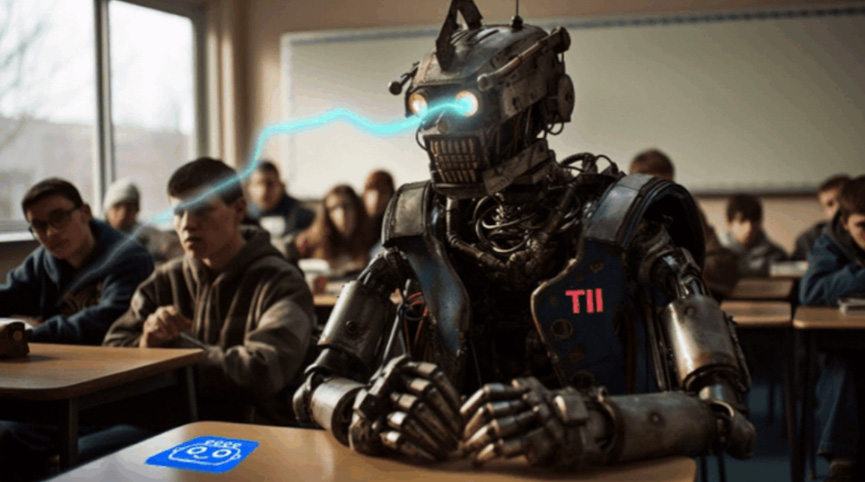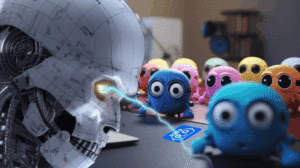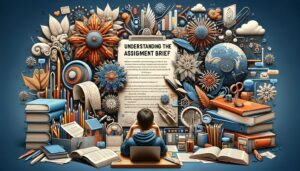Just how can Turnitin detect AI writing? This has got a lot of you students scratching your heads, and I get it.
It’s a fair question, especially if you are a big fan of AI-written work. Can’t blame ya.
I mean, we’ve all heard about this slick piece of software picking up on plagiarized stuff, but can it really spot AI writing too?

Try these new AI-powered tools:
- 5 Best AI Detectors To Unmask AI-Written Content With Accuracy
- 5 Best AI Writers To Boost Your Productivity And Content Quality.
- This "Secret AI Writer" Can Bypass AI Detection Like A Pro.
Turnitin’s gotten pretty savvy these days and come up with a nifty AI-driven detection system. This bad boy can pinpoint when text’s been cranked out by those AI writing tools. Teachers can now keep a sharp eye on any writing that smells a bit too … ahem … artificial.
So, in this post, we’re gonna get elbow-deep in what this software can do, how accurate it is, and shed some light on its abilities to spot potential copy-paste jobs courtesy of some high-falutin’ AI models.
Article At-A-Glance
-
- Turnitin’s stepped up its game and rolled out a high-tech system for picking up on writing whipped up by AI tools. This lets teachers maintain that academic honesty by spotting any such sneaky AI-crafted content in students’ work.
- Turnitin’s tech is pretty darn good, with a 98% accuracy rate, it can pick out content that’s had a helping hand from AI, or content that’s been spun out entirely by AI.
- Teachers can now tap into Turnitin’s latest AI writing detection gear. This gives them the power to pick up on any AI-generated words, including those cooked up by fancy generative models like ChatGPT.
- Sure, there’s still room for improvement, like cutting down on those false positives and refining licensing costs, but Turnitin’s made some solid strides in detecting AI writing. The education community’s given it a big thumbs up.
Table Of Contents
How Does Turnitin Detect AI Writing?
The million-dollar question in most students’ minds is: “How the heck does Turnitin figure out if AI’s been doing the writing?”
Well, it’s a mixed bag of tricks, really. Turnitin has its eyes peeled for stuff like how long the piece is, syntax patterns, how twisty the sentence structures are, sneaky prepositions, and the language style.
Then, it takes all that jazz and compares it to a boatload of human-written samples – think stuff written by folks who’ve got English down pat – that it has stashed in its digital library. That’s how it figures out if it’s dealing with something off the AI press or something actually written by an actual homo sapien.
A Bird’s Eye View Of How Turnitin Detects AI Writing
Turnitin’s got a pretty smart way to snoop out if writing’s been human-written or if it’s been entirely cooked up by a lovable AI bot.
This software uses a bunch of red flags and measures to spot machine-written gobbledygook in what’s been turned in.
It’s like training a hound dog with a bunch of scents – Turnitin has been trained with data that’s been pored over by humans. So, it can tell the difference when something doesn’t smell quite right, like it’s been whipped up by a fancy AI tool.
What’s more, this feature doesn’t care where you’re from or what language you’re speaking – it’ll find AI-written stuff no matter where it’s come from.
If that’s not enough, Turnitin also lets its users have a go at an AI detection tool if they want to do a little sleuthing on their own.
The way it does it is by using some high-tech algorithms and techniques. It looks at language patterns and watches for anything odd that might mean it’s dealing with machine-generated content.
And here’s the cherry on top: Turnitin’s got a big ol’ stash of known AI-generated essays. It takes a look at what’s been handed in and checks for any matches in its stash.
Training Process For Turnitin’s Model
Turnitin’s model for snuffing out AI writing is all about finding anything in common between what’s been submitted and its existing sources.
It watches for certain measures, red flags, and patterns in the text to figure out what’s been cooked up by an AI.
While training, Turnitin’s algorithms get to see a whole range of AI-generated content. That way, they get a feel for how AI writing is different from the human kind.
After going through stacks and stacks of text, it can spot patterns that might tip it off to writing that’s been done with the help of AI.
After going through stacks and stacks of text, it can spot patterns that might tip it off to writing that’s been done with the help of AI.
How good Turnitin is at spotting these signals can depend on how fancy the AI model that created the text was.
Making Heads Or Tails Of AI Detection Results
Turnitin’s AI writing detection gives you the whole analysis. It dishes up detailed results so users can figure out how accurate the matches are and spot any content that might’ve been lifted.
What’s The Deal With The AI Writing Detection Percentage?
When you’re taking a look at Turnitin’s AI writing detection, you might see a percentage. That’s the amount of possible AI-generated content it’s found.
That number shows how much of the text looks like it was written by something like chatbots or those fancy GPT-3 models.
It’s figured out by using measures and flags in the model that compares what’s been handed in with the usual signs of computerized text – the kind you get with article spinning, speech recognition software, and other tools that can make a copy of existing work without really getting what it means or the context.
Now, a high percentage doesn’t always mean someone was trying to pull a fast one. But it can help teachers decide if they need to dig a bit deeper into how original a piece of work or assignment really is, rather than just relying on a once-over.
Accuracy Of Turnitin’s AI Writing Indicator
Turnitin’s pretty confident about its AI writing indicator tool – it’s saying it’s got a 98% hit rate when it comes to spotting language that’s been knocked up by AI.
This gizmo takes in what students and teachers feed it, and it’s pretty good at catching AI-generated writing.
Thanks to a real smart algorithm, it’s always on the lookout for patterns in the text that might smell a bit like AI. It also gives an overall match rating on the student’s work.
Because of its scientific way of doing things, Turnitin can give a pretty reliable heads-up on whether a piece of work’s been cranked out by AI models like ChatGPT or OpenAI GPT3.
Because of its scientific way of doing things, Turnitin can give a pretty reliable heads-up on whether a piece of work’s been cranked out by AI models like ChatGPT or OpenAI GPT3.
That said, it ain’t perfect. There have been a few false alarms reported by teachers using the detector. So, Turnitin’s decided to slap on an asterisk when their model reckons there’s AI writing in less than 20% of the doc.
Handling Those Pesky False Positives
In order to up its game on the accuracy front and weed out false positives, Turnitin’s whipped up its own system for detecting AI writing. It’s a bit like having a ChatGPT-detector on hand.
This detector’s designed to pick up on different kinds of AI writing, looking out for giveaways like sentence structure, choice of words, typos, grammar slip-ups, and other hiccups you might find in machine-generated text.
It throws a flag on any text that looks like it might’ve been churned out by a machine, then it’s over to the experts for a closer look.
To give teachers a better handle on false positives, Turnitin’s added a feature that puts an asterisk next to anything where its algorithm found less than 20% AI writing in the text handed in.
To give teachers a better handle on false positives, Turnitin’s added a feature that puts an asterisk next to anything where its algorithm found less than 20% AI writing in the text handed in.
This lets teachers quickly spot cases where there’s only a smidgen of computer-generated stuff that needs a closer look before they make a call on a student’s work.
Looking At The Detection Big Picture
Turnitin’s AI writing detection tech can zero in on a bunch of different AI-generated and AI-assisted writing. It gives teachers a sharp tool in their belt for sniffing out any funny business.
What Types Of AI Writing Can Turnitin Pick Up?
Turnitin’s AI writing detection tech can help teachers pick up on text that’s been cooked up by generative AI tools like ChatGPT and GPT3.
The company’s tailor-made model uses a mix of measures, flags, and training tricks to figure out what percentage of a student’s paper might’ve been written by an AI.
This tool’s a godsend for schools trying to sniff out when students might’ve used AI writing tools to jazz up their work. It helps keep student work original and above board.
The AI writing detection is about 98% on the money when it comes to spotting language that’s been rolled out by machine learning tech. This lets teachers easily spot any sources that might’ve been passed off as legit student work.
Turnitin’s got its eyes peeled for models of generative text – think stuff like summarization models like markdown or paraphrasing models like SummarizeBot, and others.
On top of that, it keeps an eye on the next-gen versions of these models. That way, it’s baseline analysis stays sharp, even as these models get more fancy over time.
Future Proofing For Advanced AI Essays
Turnitin ain’t resting on its laurels when it comes to outsmarting crafty AI writing. It’s all about staying one step ahead and beefing up its defenses for those tricky advanced AI models.
For instance, Turnitin has got its feel for GPT-3 and GPT-3.5 and worked them into its toolset. These high-falutin’ language models can whip up text that looks just like something a human might scribble down.
Even ChatGPT is getting a good once-over, seeing as this AI is a sneaky little devil when it comes to catching plagiarism and other shenanigans in academic circles.
It’s a whole new ballgame for Turnitin’s whizz kids, and they’re gonna need to pull a rabbit out of the hat before these tools become the norm in colleges and universities.
ChatGPT is pretty fresh off the press in terms of AI tech apps. It’s a whole new ballgame for Turnitin’s whizz kids, and they’re gonna need to pull a rabbit out of the hat before these tools become the norm in colleges and universities.
Here’s a neat tidbit: one smart cookie from Princeton University did a study using something called “GPT Zero.” This is like a souped-up version of ChatGPT that digs deeper than just skimming for usual stuff folks look for when trying to catch cheaters or other no-goodniks that Turnitin is gunning for.
This project took a good hard look at the lingo cues and potential diffs between machine-made and human-made work. Turnitin is betting on testing the bejeezus out of these newfangled technologies so they can stay king of the hill when it comes to sniffing out AI writing and offering tailor-made digital tools for schools and big businesses alike.
Sniffing Out AI-Generated Paraphrased Content
Turnitin’s AI writing detection tool ain’t no slouch when it comes to catching paraphrased content cooked up by AI models like GPT-3 or GPT-3.5.
It uses a whole slew of measures and flags to spot anything out of the ordinary or patterns that smell like AI-generated writing versus stuff that’s been written by a real live person.
These measures include stuff like sentence length, how diverse the words are, language model scores, document graph clusters, and other fancy comparisons at the semantic level specific to the security used in creating the text.
To make sure it’s on the money, Turnitin has trained its algorithm to handle each type of AI-generated content. So, a paper whipped up by ChatGPT is gonna get a different kind of once-over than one cooked up using other AI tools or language models.
How accurate Turnitin is at catching this kind of hanky-panky can swing a bit depending on the language model used to churn out the text. For example, papers written with GPT-3 might trip the alarm more often than papers written using something different like ChatGPT.
Plans For Sniffing Out Paraphrasing Tools
Turnitin’s got big plans to catch AI-generated content that’s been reworked or paraphrased.
Turnitin’s AI writing detector’s gonna lean on deep learning to spot potential copycats and tell if the text’s got any AI-written content in it.
This detection strategy lets teachers see when students might be using tools like ChatGPT, which can spit out essays without the person having to know anything about the subject or even having to read the essay question.
Turnitin’s aiming to put the kibosh on academic shenanigans tied to AI-generated content by giving teachers a fast and easy way to keep their coursework honest and fair.
Turnitin’s aiming to put the kibosh on academic shenanigans tied to AI-generated content by giving teachers a fast and easy way to keep their coursework honest and fair. It lets them catch and stop fraudulent assignments created using tools like GP-3.
Access And Licensing Options
Turnitin gives folks the chance to tap into their fancy AI writing detection tech with all sorts of licensing options. We’re talkin’ one-off licenses for lone wolves all the way to big ol’ site licenses for colleges and corporations.
Who Gets to Play with Turnitin’s AI Writing Detection Gizmo
Turnitin’s got this AI writing detection tool all set up to help teachers and schools figure out when some AI’s been sneaky and done the writing for the students.
Schools, colleges, and other brain-building places get to use this tool. The cost of getting in on the action depends on the plan they pick and there might be some extra setup fees to get things rolling.
Turnitin’s even whipped up a resource page that spills the beans on how to get the most out of the software. The page has got updates from different news sources, too.
For teachers looking to grade their students’ work fair and square and catch any copycats, Turnitin’s AI writing detection solutions open up a world of possibilities.
Availability And Extra Costs For The Gizmo
Turnitin’s AI writing detection is ready and waiting for educational institutions. They can take it for a test drive without having to fork over any extra dough.
The trial can be run through Turnitin’s existing services or contract solutions for a set amount of time.
Turnitin gives extra support for access and licensing of its AI smarts at a price that won’t break the bank, though the final cost could swing depending on a few things.
Keeping Things Honest While Riding The AI Tech Wave
Turnitin’s AI writing detection tool is a real boon for teachers who want to keep things on the honest in their classrooms.
The tool can spot language written by AI with 98% accuracy and it doesn’t matter whether the text was completely whipped up by AI or just got a helping hand.
Turnitin’s recent rollout of this AI writing detection software makes it a breeze to catch text cooked up by AI tools, like ChatGPT.
With better accuracy and the chops to spot even the more advanced generative models, Turnitin’s tool is a must-have for any teacher who wants to make sure their students are turning in their own work.
With better accuracy and the chops to spot even the more advanced generative models, Turnitin’s tool is a must-have for any teacher who wants to make sure their students are turning in their own work.
Sure, there’s still some room to get better at catching false positives, tweaking the pricing for extra licenses, and making the results easier to understand.
But overall, the folks in education are giving two thumbs up to these steps toward spotting AI writing as we all get comfier with our AI tech-heavy future.
Meet our resident tech wizard, Steve the AI Guy. Now, before you get any wild ideas, let’s clear up one thing – he’s 100% human! I mean, he’s got the work history to prove it. He spent a decade diving into the deep end of the tech industry doing business intelligence work, splashing around with two of the world’s largest business consulting companies, Deloitte and Ernst & Young. Learn More










